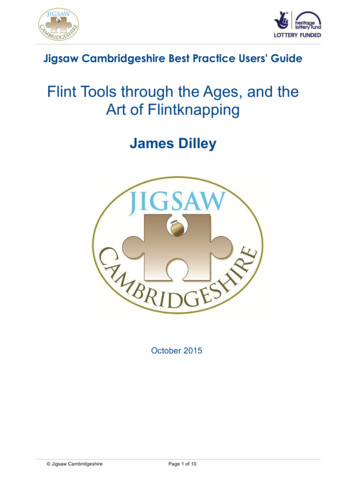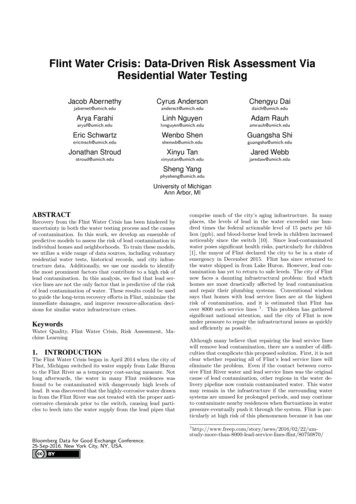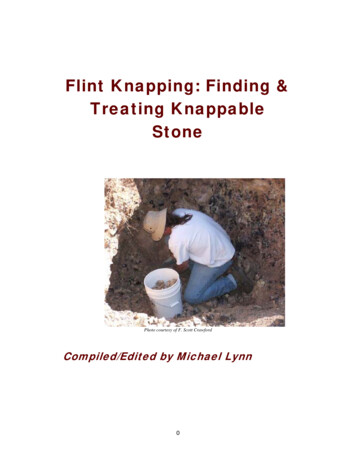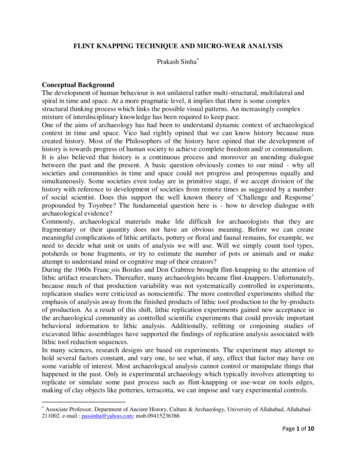
Transcription
Jigsaw Cambridgeshire Best Practice Users' GuideFlint Tools through the Ages, and theArt of FlintknappingJames DilleyOctober 2015 Jigsaw CambridgeshirePage 1 of 10
1 FLINT AND FLINTKNAPPINGFlint (SiO2 - Silicon Dioxide) is a bio-sedimentary material that was formed in the ocean millionsof years ago. It is almost pure silica, containing less than 5% impurity in the form of CalciumCarbonate and other trace elements, such as sodium and potassium which are found in differentproportions from different sites, thus allowing analysis to determine the source of flint tools. Itsvery fine crystalline grain gives flint a glassy character that when struck, fractures conchoidally,which makes it perfect for knapping. Other materials that contain a very high quantity of silicacan also be knapped such as obsidian, glass, chert, baked porcelain and even fossilised wood!Fossil sea urchin sealed within a nodule ofNorfolk flint with many of its spine bases stillattached. Such preservation is very rare.Scientists are still not totally sure how it wasformed, but we can tell due to the faults in theflint and patterns that appear when flint is brokenthat the remains of sea creatures play a largerole in the formation of flint. It is likely that whenan organism dies it sinks to the sea bed andbegins to decay. It is at this point the high levelsof silicon particles in the sea at that time wouldhave stuck to the decaying remains, eventuallysealing it in a cocoon of silicon. This nodule ofsoft silicon expanded and hardened, eventuallyforming layers of flint that we see today at thebeach in chalk cliffs such as those at Dover. Thelayers of flint represent what once would haveprobably been a soft mass of silica, compressedinto thinner bands. The concentric layers of chalkand flint are likely to show environmental cyclesbetween shallow lagoons and slightly deeperwater that determined formation of chalk or flint.Puzzling giant flint formations known asParamoudra and flint circles are found aroundEurope but especially in Norfolk. They are popular garden features but remain mysteries togeological understanding.2 PEOPLE OF THE STONE TOOLSHomininsThe oldest stone tools currently pre-date genus Homo, they werefound in Kenya (Lake Turkana) and date to 3.3 million years ago.This discovery pushed back the date for the earliest stone tools by700,000 years! Meanwhile in Britain, the oldest evidence of homininsand stone tools currently dates to around 850,000 years ago. Thesecome for the eroding cliffs at Happisburgh (Norfolk). This is currentlythe start of the Lower Palaeolithic (Old Stone Age) in Britain) andlasts until 350,000 years ago. Within the Lower Palaeolithichominins such as Homo heidelbergensis would have moved in andout of Britain in between cold seasons. Their toolkit would havetypically included the handaxe which comes in a variety of shapesand sizes. As well as this would have been basic flake-based toolssuch as scrapers and notches.A large ovate handaxe such as this require a great deal of skill and experience to make, but not too much time.From scratch this handaxe took only 50 minutes to make. Such tools made ideal butchery implements as shownby experimental archaeology. Jigsaw CambridgeshirePage 2 of 10
These early groups would have scavenged and hunted using basic equipment such as firehardened spears. Their prey included most large mammals including Woolly Rhinoceros andGiant Elk which would have stayed relatively close to river systems for water. This is why mostLower Palaeolithic sites are found as part of ancient river deposits.By 350,000 years ago, Neanderthals were operating in Britain. They were skilled hunters whoused composite technology to give them a better advantage over prey. They were able to bindand glue stone tips to spears using plant fibre or animal skin for cordage and birch bark tar forglue. Neanderthals are well-known for utilizing caves and rock shelters for dwelling spaces. Liketheir ancestors in the Lower Palaeolithic, they hunted large mammals and butchered them wherethey fell. Neanderthals used a wider variety of tools including the handaxe towards the end ofthe Middle Palaeolithic. They are well known for producing implements using a technique called'Levallois'. This process involves preparing a core and detaching a single flake of apredetermined form. Neanderthals started to disappear around 40,000 years ago anddisappeared completely by 30,000 years ago.They were succeeded by anatomically modern humans (us!). However there was a period ofseveral thousand years in which Neanderthals and modern Humans overlapped in time. It is notknown if there would have been any kind of interaction between the two but it is considered verylikely. With only modern humans (Homo sapiens) left, the Middle Palaeolithic ended. The finalpart of the Old Stone Age was the Upper Palaeolithic, 40,000 – 12,000 years ago. At this timehumans would have been highly active and moved between seasonal bases. They would havefollowed herd animals such as deer, horses, reindeer and bison. This period is most well-knownfor cave art which not only appeared on cave walls but also as statuettes and stylised huntingequipment. In Britain, there is rock art in the caves of Creswell Crags which is located in alimestone gorge (Notts).Like Neanderthals before, anatomicallymodern humans used caves for shelter; itwas only at the end of the UpperPalaeolithic in Britain that people started touse free standing shelters. Even then,caves were still used. Groups would havehad a wide area they covered seasonally tocollect resources and avoid the cold duringthe winter. From Wales, the 'Red Lady ofPaviland' is actually the burial of a youngman from the earlier part of the UpperPalaeolithic; he was buried with ivoryornamentation and covered in red ochre.Red ochre is a natural iron pigment used topaint the frescos at Lascaux and manyThese spear points require several stages of careful flaking toother cave art sites.thin them down enough to be used for spears. They areespecially well known in France and Spain where they wereproduced during the Solutrean, unfortunately this culture hasnot yet been found in Britain.MesolithicThe Upper Palaeolithic ended with the retreat of the last glacial maximum around 2,000 yearsago, it was followed by the Mesolithic or Middle Stone Age, which continued until around 8000years ago. People still lived nomadically but returned to seasonal camps between the summerand winter. Generally summer camps were inland so hunters could track large mammals whilewinter camps were near the sea for the food security the sea offered. Dwellings are thought to Jigsaw CambridgeshirePage 3 of 10
be tent-like structures made of wood in tepee or bender shelter arrangements, then covered inanimal skins and/or bark panels. These light shelters were quick to erect and light to transportmaking them ideal for seasonal movement. In Mesolithic Britain, people focussed their huntingon deer as there were large numbers at this time. Britain was also attached to the mainland via aland mass known as “Doggerland”. Britain was connected to the continent several times duringprehistory which allowed new groups access and cut off others when the connection wasdrowned by the sea. The Mesolithic was the last time Britain would be connected to thecontinent.The bow and arrow appeared duringthe Mesolithic although no actualbows or arrows (except thearrowheads) have been found inBritain. Full sets of bows and arrowshave been found in waterloggedconditions in Denmark dating to theMesolithic. Laminar blade technologywas a process used in the UpperPalaeolithic to produce many longblades by single strikes from onecore. This was continued into theMesolithic although flintknappers The Star Carr headdresses are certainly one of the great mysteriesgenerally fully exhausted the cores from British prehistory. There have been a number of theories as tobefore discarding them. Some of the exact purpose of these unusual objects.thebladesproducedwereretouched into tiny microliths which could be set into arrow shafts or harpoons for fishing. Thefirst type of tree felling axe was also produced, known as the “tranchet” axe. This was a simple,flaked axe with a flake removed from the blade which made it very sharp, although slightlyfragile. These were almost certainly used in the acquisition of timber and for land clearance toaid hunting. Over 100 were found at Broom Hill (Hants), which are suspected to be part of largescale woodworking or land management. Star Carr, in the Vale of Pickering (Yorks), is probablyBritain’s most well-known sites. Here, archaeologists found a wooden platform and evidence ofdomestic activity. The most intriguing finds were over 20 sets of red deer antler frontlets. They allhad two holes drilled into the skull caps, it has been assumed for many decades that these areheaddresses for ritual or hunting disguise.NeolithicThe Mesolithic was followed by the Neolithic or New Stone Age around 7000 years ago. It was inthis period that pottery, agriculture, polished tools and monument-building appeared. Theoverlap period in between saw a gentle transition from semi-sedentary hunter- gatherergroups or more static settlements. Within the Neolithic material culture, there is clear evidenceof craft specialisation not seen consistently before. The stone tools in the Neolithic becamespecialised although there were a number of tools that continued from earlier periods such asscrapers and piercers. Stylised arrowheads in the Neolithic started with the leaf arrowhead, thenchisel, oblique and finally barbed and tanged into the early Bronze Age. Polished stone axeswere also a major part of Neolithic community, both as a functional tool and also as an importantsocial marker. It was thought for many years that good quality stone (especially flint) was traded.However there is no evidence of actual economy based around flint apart from the finished toolsand flint mines such as Grimes Graves (Norfolk). A more likely theory is that groups travelled torough out nodules at a source then travelled back with their half-finished flint blocks. This issupported by environmental data from raw material source sites that show extraction wassporadic and irregular, not a constant industry. Jigsaw CambridgeshirePage 4 of 10
Neolithic arrowheads with theearliest (left), the leaf arrowhead.The latest, the barbed andtanged arrowhead (middle).Finally the chisel arrowhead(right), from the middle Neolithic.Bronze AgeBurial practice suggests society was becoming less egalitarian towards the end of the Neolithic.Individuals are placed within their tombs with grave goods that often included stone tools suchas axes or dagger blades. This continued into the Bronze Age, with arrowheads in particularbeing placed in male graves with other archery equipment. In terms of flintwork in the BronzeAge, arrowheads and some daggers blades known as 'beaker daggers' generally hold thelimelight for discussion. However there is also a strong appearance of basic core and flakeassemblages with many flake-based tools. Flint is certainly used as the primary material forcutting tools in the early Bronze Age, while metal remains a high status material. It is only in thelater Bronze Age that flintwork starts to really die out. At this time the quality of flaking is verypoor and consists of only very crude removals from cores.Post-MedievalAfter a few thousand years of only being used for masonry, the use of flint changed with theinvention of the firearm. 'Flintlock' is a general term for any hand-held firearm based on theflintlock mechanism. Introduced in the early 17th century, the flintlock rapidly replaced earlierfirearm-ignition systems, such as the 'Matchlock' and 'Wheellock'. It continued to be in commonuse for over two centuries, replaced by percussion cap and later, cartridge-based systems in theearly-to-mid 19th century.The 'Snaphaunce' or 'Snaplock' was the early form of a flintlock, first used in southern Germanyaround 1570s. Flint is attached to a spring-loaded arm, and when the trigger is pulled, a coverslides off the flash pan allowing the arm to snap forward, striking the flint against a metal plateover the flash pan. Hopefully enough hot sparks are created to ignite the powder. Thismechanism was much simpler and less expensive than the Wheellock.In 1608, Marin le Bourgeoys (ca. 1550–1634) from Lisieux in Normandy was appointed to theLouvre gun shops in France. By combining improvements in prior firearm mechanisms, hecreated the first flintlock for King Louis XIII shortly after his accession to the throne in 1610. Hereplaced the separate steel and manually operated pan cover with a spring-loaded frizzen andalso introduced an intermediate position between the released and full cock positions (known asthe half-cock position). So the flint was held away from the frizzen, but the trigger could notrelease the cock, preventing it from firing and making it much safer. Marin le Bourgeoys' designwas very popular and was used in various forms throughout Europe by 1630 and was the Jigsaw CambridgeshirePage 5 of 10
standard in firearm use until the 1840's, when it was finally replaced by percussion lock systems.The flint scrapes off particles of iron as it contacts the striking surface and the friction rapidlyignites the iron to form Magnetite (Fe3O4) sparks, which lights the gunpowder, firing the ballfrom the barrel. Each flint would produce enough sparks for up to 50 shots.Northern Arabs acquired the Snaphaunce and Flintlock technology in the late 1600's and oftenredesigned their long guns with a sharply curving butt, so that they could be easily tucked underan arm for single-handed firing from the back of a moving camel or horse. Swedish inventorSven Åderman is credited with creating a rapid firing musket that was first used in the GreatNorthern Wars of King Charles (Karl) XII of Sweden. For his efforts, Åderman was given thehunting estate of Halltorps by King Frederick I of Sweden in 1723.In 1790 Philip Hayward received a musket flint army order for "100,000 flints of the best sort"and so was born the Brandon Gunflint Company. At the time of the Napoleonic Wars (around1804) nine Brandon gunflint makers were commissioned by the Board of Ordnance to supply360,000 flints a month to the gunsmiths working in the Gun Quarter area of Birmingham.These were for the famous Baker Rifle; a muzzle-loading flintlock, that has the distinction ofbeing the longest service rifle in the British Army.Brandon flintknappers prospered until just before the Battle of Waterloo (1815) when all thegunflints for the British Army were ordered from Brandon. In 1813, fourteen Brandon FlintMasters were supplying more than 1 million flints a month and employing around 160 knappersand diggers. In 1816 however, the order was nil, which lead to the unemployment of manyknappers.A beautiful engraving (A.J. Forrest 'Masters of Flint') of a Brandon Flint shop in 1876, shows the flint master atwork with his apprentice. The apprenticeship lasted for seven years, but boys leaving schools generallylooked for other jobs to avoid the killer dust. Jigsaw CambridgeshirePage 6 of 10
Around 1868, the gunflint industry engaged around 36 men, but employed 10 fewer in 1878.Between 1880-1885 over twenty million gunflints were shipped from Brandon to Zanzibar(Africa), packed in old flour barrels (29,000 per barrel). At the end of the 19th century, Brandonwas supplying about 4 million gunflints a year to Africa, China, Java, Sumatra, Malay and LatinAmerica.In central France, the towns of Meusnes, Noyers and Couffy also had thriving gun-flintindustries, with 800 workers employed to make thirty million gunflints in 1794. French flints areeasily distinguished by their honey- yellow or blonde colour.The flint mechanism was eventually replaced with the invention of the percussion cap and thelater breech- loading cartridge. At the end of World War II there were around five knappers left atBrandon, however South Africa’s withdrawal from the Commonwealth in 1961 led to theimposition of a voluntary United Nations arms embargo in 1963 - this ended the flintknapperstrade to Africa.3 THE ART OF FLINTKNAPPINGThe word “knapping” derives from the Germanic word “knop” which meant to strike or shape.'Flintknapping' is generally recognised as the complete term in the UK, as flint was the mostcommonly used material for knapping. It is easiest to break the process down in a set ofgeneralised stages although these are not the rule and differ with technique and material.Below are the stages of knapped used to make a Neolithic style axe head using Suffolk flint. Iused a selection of hammer stones, an abrader and an antler hammer.Here is the nodule of flint in its raw, untouchedstate. You can see some of the flint under thequarry dust and cortex. The cortex is the chalkyskin that covers the flint, it protects it from frostdamage to some extent but is generally removedduring knapping. My first flake will usually bewhere this is an angled edge where flint is visiblesuch as at the top of the nodule.The first few largest flakes are created with thelargest hard hammer. Most of these will removeany visible surface problems, such as flat edgesor ridges. Much of the cortex is removed at thisstage. As with all the flakes detached, the blowsmust be at the edge of the flint. The edge itselfmust also be under a 90 angle otherwise the flintwill not flake. The area struck to remove a flake iscalled the platform. Jigsaw CambridgeshirePage 7 of 10
I will use the hammer stone to start shapingthe flint to the rough shape desired. So longas there are no natural flaws or cracks, Ishould not have a problem. When strikingthe platform I generally make my blows nodeeper than 1-2cm from the edge. I work allthe way around the nodule removing flakesfrom both sides to start to create a lensprofile. This will help me refine the axeheadlater.As you can see I generally try toface the area I want to striketowards my hammer stone. Thismakes the movement of flakingeasier and improves accuracy. I alsotilt the flint slightly downwards, thisencourages successful flaking. It isimportant to check each freshlyflaked area of the flint beforecontinuing in case there are anynew issues I need to address orcorrect.I continue to flake around theaxehead, refining the shape. I canuse the ridges or flake scars asenergy highways to direct my flakes.The energy I put into the flint witheach strike travels at the surface, anyridges or high points will focustravelling energy. Notice that I havereduced my hammer stone size,since the areas I am aiming for aresmaller so I want to ensure I hit theright spot. Jigsaw CambridgeshirePage 8 of 10
Before moving on to the antlerhammer and final refinement; I needto abrade the edges. This removesthe razor sharp, thin edge that wouldshatter if I struck it. But by pushingthe edge back to a thicker area it isstrong enough to take the blow of asoft hammer. This results in a cleanflake with no crushing. I will abradean edge again with each antlerhammer removal.A strike with an antler or softhammer clips the edge of the flintrather than makes a blow on top ofthe edge (as with the hardhammers).Antlerworkswellbecause it is softer than the flint; thismeans that when connection ismade the flint bites into the antler.With the downward force of theantler; the flint is forced to flake off ata thin and lateral plain. This type offlaking means I can remove muchthickness but only need to sacrifice alittle surface area.Here is the finished axe head, it onlytook around 20 minutes to flake, butthis is not the longest part of makinga Neolithic axehead. It is at this pointI would take the axehead to a largeabrasive stone in the landscape andgrind it against it. This starts to workoff the ridges and surface and leavesa smooth, polished finish. Anaxehead like this would require over50 hours work. The polishingprocess certainly improves thelongevity of the axehead.but this is not the Jigsaw CambridgeshirePage 9 of 10
Find Ancient Craft onlineatwww.ancientcraft.co.ukor on Twitter at@ancientcraftuk orFacebook: AncientcraftUKor Instagram:Ancient CraftFor personal, educational and non-commercial use of this booklet: You may copy small pieces ofinformation or up to two (Ancientcraft owned) low resolution images, for personal or educational (noncommercial) purposes, or for the promotion of events attended by Ancientcraft, provided full referenceand credit is given to Ancientcraft.For Commercial use of this booklet: You may not copy, reproduce, republish, download, post,broadcast, transmit, make available to the public, or otherwise use the AncientCraft booklet contents inany way without permission. Jigsaw CambridgeshirePage 10 of 10
Flint (SiO2 - Silicon Dioxide) is a bio-sedimentary material that was formed in the ocean millions of years ago. It is almost pure silica, containing less than 5% impurity in the form of Calcium . which makes it perfect for knapping. Other materials that contain a very high quantity of silica can also be knapped such as obsidian, glass, chert .










